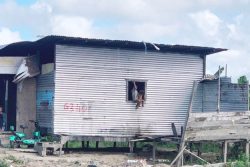The COVID-19 pandemic has brought to the forefront some of the most pressing global challenges that humanity has faced in recent history. Health systems have been stretched thin and lockdown measures have taken a heavy social and economic toll, the devastating impacts of which are being felt by all.
As countries respond to this global crisis, the focus is on strengthening health systems, cushioning the knock-on effects on livelihoods and economies, and building back better. The path ahead represents a once-in-a-lifetime opportunity to shift the global development paradigm towards greater sustainability and a greener, more inclusive economy.
Forests and trees provide income, livelihoods, and well-being for rural populations, particularly indigenous peoples, small-farm holders, and other forest-dependent communities that live near forests. Forests mitigate climate change by removing about a third of the global greenhouse gas emissions each year. Furthermore, the forestry sector produces essential products and services which underpin public health the world over.
If the crisis continues unabated, this reliance on forest goods and services is also likely to see a sharp increase. Which raises the question of how we ensure that forests continue to play a central role in people’s wellbeing, without raising the risk of deforestation and forest degradation.
Sustainable forest management can play a vital role in lifting millions out of poverty, and in building resilient economies and societies that can withstand pandemics, climate change and other global challenges. For this to happen, governments, the United Nations system, and other key development partners will need to take swift decisive action to build sustainable forest-based solutions into their COVID-19 responses.
The global turmoil that the pandemic has created will almost certainly increase global poverty. Recent analysis indicates that COVID-19-related loss of jobs and income will likely push 34.3 million more people into extreme poverty in 2020. In the worst-case scenario, 160 million more people could face extreme poverty by 2030.
This crisis will disproportionately affect today’s most marginalised groups, including the rural poor and in particular, indigenous peoples living in forests. Many indigenous peoples have a deep cultural and spiritual relationship with ancestral forests and are the keepers of traditional knowledge on forest biodiversity, much of which is at risk of being lost. Indigenous peoples tend to be in the most “vulnerable” health category, due to higher rates of communicable and non-communicable diseases, high mortality rates, and lower life expectancies.
Around 2.4 billion people – one-third of the world’s population – still rely on wood fuel to meet their basic energy needs, such as cooking food, boiling water, and heating their homes. Reliance on forest biomass energy will likely grow during the COVID-19 crisis, as supply chains of other energy sources get disrupted, and income-generating opportunities decrease.
The sharp increase in economic vulnerability will in turn increase pressure on forests to play their safety-net role once again, as more people amongst the rural poor turn to forest products for their fundamental subsistence needs.
Many essential supplies that public health systems rely on are derived from forest products, as witnessed by the fact that forest industries have been deemed as essential industries since the COVID-19 lockdown.
Among urban populations, increased reliance on e-commerce shipments and home delivery services during COVID-19 lockdowns has also placed the spotlight on the need for paper and cardboard-based packaging products in enabling delivery of food products and other household items to people’s homes. In addition to these consumable products, green spaces, city parks and forests are vital for the health and wellness of communities.
The use of outdoor recreation facilities has been a social distancing appropriate alternative – such as hiking, biking, camping, fishing, bird-watching, and nature walks. Being in forests or parks with trees offers a myriad of benefits for human physical, mental and spiritual health.
A 2020 study by leading economists found green fiscal recovery packages to be the most beneficial for COVID-19 recovery and identified five policy areas in this regard, namely, clean physical infrastructure, building efficiency retrofits, investment in education and training, natural capital investment, and clean research and development.
A 2020 study found that deforestation could lead to a rise in the occurrence of diseases like COVID-19 in the future. The study’s findings suggest that when forests are cleared for agricultural use, the chances of transmission of zoonotic diseases increase. Ecosystem degradation, large-scale deforestation, illegal trade in wildlife and climate change are all drivers of emerging zoonotic diseases. Climate change influences environmental conditions which in turn affect the spread of pathogens, vectors and hosts. As the global climate continues to change, it is expected that outbreaks of epidemic diseases are likely to become more frequent.
As the global community battles the COVID-19 pandemic, it is increasingly clear that building back better will require a quantum shift in the approach to disaster preparedness. While the current crisis was unimaginable a few months ago, it is unlikely to be the last global crisis the world will face.
An edited version of a UN Department of Economic & Social Affairs economic analysis published in June





